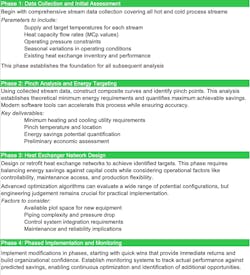Energy Saver: Why Chemical Plants Are Burning Cash Instead of Recovering Heat
Are you leaving $7.7 million on the table? A single chemical plant identified annual energy savings worth that much through an analysis that took just months to complete. The payback period? Less than two years. The solution? None other than your chemical engineering 101 heat integration through pinch analysis and heat exchanger network optimization.
This is the documented reality for a chemicals facility in Texas where strategic heat integration delivered 2.2 million MMBtu in annual energy savings (U.S. Department of Energy, 2005). Yet despite such compelling evidence, countless chemical plants continue operating with suboptimal heat-recovery systems, essentially burning cash along with their energy.
As energy costs soar, the question is not whether your plant can benefit from heat integration, it is a matter of how much you are losing by not implementing and continuously refining it.
Foundations of Heat Integration
Heat integration fundamentally reimagines how we view energy in chemical processes. Instead of treating hot and cold streams as independent entities requiring separate heating and cooling utilities, heat integration systematically captures waste heat from hot streams and channels it to cold streams that need warming.
The fundamentals of effective heat integration lie in pinch analysis, a thermodynamic method that has evolved into the industry standard for energy recovery (Linnhoff & Hindmarsh, 1983). The analysis begins with composite curves, graphical representations that map the cumulative heating and cooling demands across all temperature levels in a process.
The key insight comes at the "pinch point," where hot and cold composite curves approach most closely. This point represents the thermodynamic bottleneck that limits heat-recovery potential. Above the pinch, the process is heat deficit; below it, heat surplus. This fundamental principle guides optimal heat exchanger network design by establishing these three clear rules: Don't use hot utilities below the pinch; don't use cold utilities above it; don't transfer heat across the pinch.
From Analysis to Implementation
Modern heat exchanger network (HEN) optimization builds upon pinch analysis foundations using sophisticated algorithms and simulation tools. Typically, the goal is to achieve identified energy targets with minimum capital investment while maintaining operational flexibility (Smith et al., 2010).
The $7.7 million annual savings example is a well-documented assessment from a public-private partnership with U.S. Department of Energy and an 800-employee facility in Deer Park, Texas. The pinch analysis was applied across four major production areas: methyl methacrylate, acid recovery, acrylate monomers and acetone cyanohydrin plants.
The assessment identified specific opportunities, including modifying thermal oxidizers in the acrylate monomers plant, rebalancing steam systems in the acetone cyanohydrin plant, optimizing heat exchanger networks across all four production areas and implementing cross-plant heat integration strategies. At the time, the assessment cost $300,000.
Energy reductions of 20%-50% in chemical plants optimizing heat exchanger networks are commonly reported (Sreepathi & Rangaiah, 2014). The variation depends on initial efficiency levels and process characteristics, but even efficient plants find a 15%-25% additional savings potential.
Your Roadmap to Implementation: A Systematic Approach
Heat integration in a chemical plant requires a structured methodology that balances technical rigor with practical implementation constraints. It can be useful to consider key phases for implementation.
Heat integration implementation faces several practical challenges that must be addressed systematically. Modern chemical plants involve hundreds of process streams with complex interdependencies. Advanced simulation tools help manage this complexity, but successful implementation requires experienced engineering teams familiar with heat-integration principles, specific process requirements and the site in question.
Heat-integration changes can affect process operability and control. Careful attention to control system design, operator training and startup procedures ensures smooth transitions without production disruptions.
While payback periods are typically short, upfront capital requirements can be substantial for major retrofits. Phased implementation strategies can help manage cash flow while delivering early returns that fund subsequent phases.
Heat integration represents one of the chemical industry's most reliable paths to improved competitiveness. The technology is mature, the benefits are proven and the methodologies are well-established. The question isn't whether heat integration works, it’s whether you can afford not to implement it.
References
Linnhoff, B., & Hindmarsh, E. (1983). The pinch design method for heat exchanger networks. chemical engineering science, 38(5), 745-763.
Smith, R., Jobson, M., & Chen, L. (2010). Recent development in the retrofit of heat exchanger networks. Applied Thermal Engineering, 30(16), 2281-2289.
Sreepathi, B. K., & Rangaiah, G. P. (2014). Review of heat exchanger network retrofitting methodologies and their applications. Industrial & engineering chemistry research, 53(28), 11205-11220.
U.S. Department of Energy. (2005). Rohm and Haas: Chemical plant uses pinch analysis to quantify energy and cost savings opportunities at Deer Park, Texas. Industrial Technologies Program Case Study. DOE/GO-102004-1888
Wang, Y., Pan, M., Bulatov, I., Smith, R., & Kim, J. K. (2012). Application of intensified heat transfer for the retrofit of heat exchanger network. Applied Energy, 89(1), 45-59.
Wang, B., Arsenyeva, O., Zeng, M., Klemeš, J. J., & Varbanov, P. S. (2022). An advanced Grid Diagram for heat exchanger network retrofit with detailed plate heat exchanger design. Energy, 248, 123485.
About the Author
Thomas Kwan
Global Vice President, Strategic Innovation and Industrial Ecosystems
Thomas Alan Kwan is an energy transition expert at Schneider Electric's Sustainability Research Institute. With a Ph.D. in chemical and environmental engineering, he brings a blend of academic rigor and industrial experience to the field of sustainable manufacturing and green engineering.
At Schneider Electric, he leads initiatives focused on new and emerging industrial systems, with a particular emphasis on the chemical processing sector. His work involves developing innovative solutions and practices to drive energy, environmental and economic benefits.
Previously, he was a key member of Unilever's product engineering team, where he integrated green chemistry and engineering principles for product and process development. His contributions earned him a lifetime honorary membership on the team. Kwan also has experience in environmental regulation, having worked with the U.S. EPA on Clean Water Act programs.
Through his research and collaborations, Kwan continues to explore innovative ways to reduce energy consumption, minimize waste, maximize value and improve overall process efficiency in chemical manufacturing operations.


